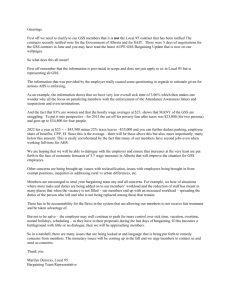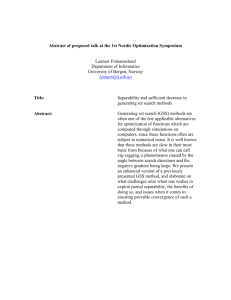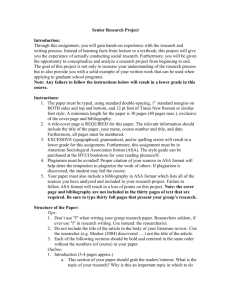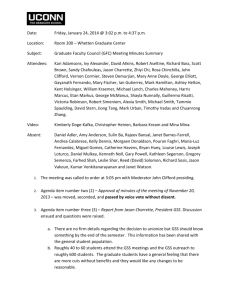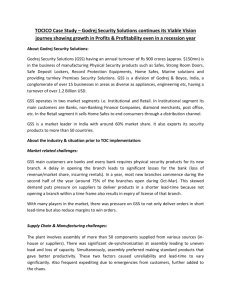Chapter Three: Research Methodology
advertisement
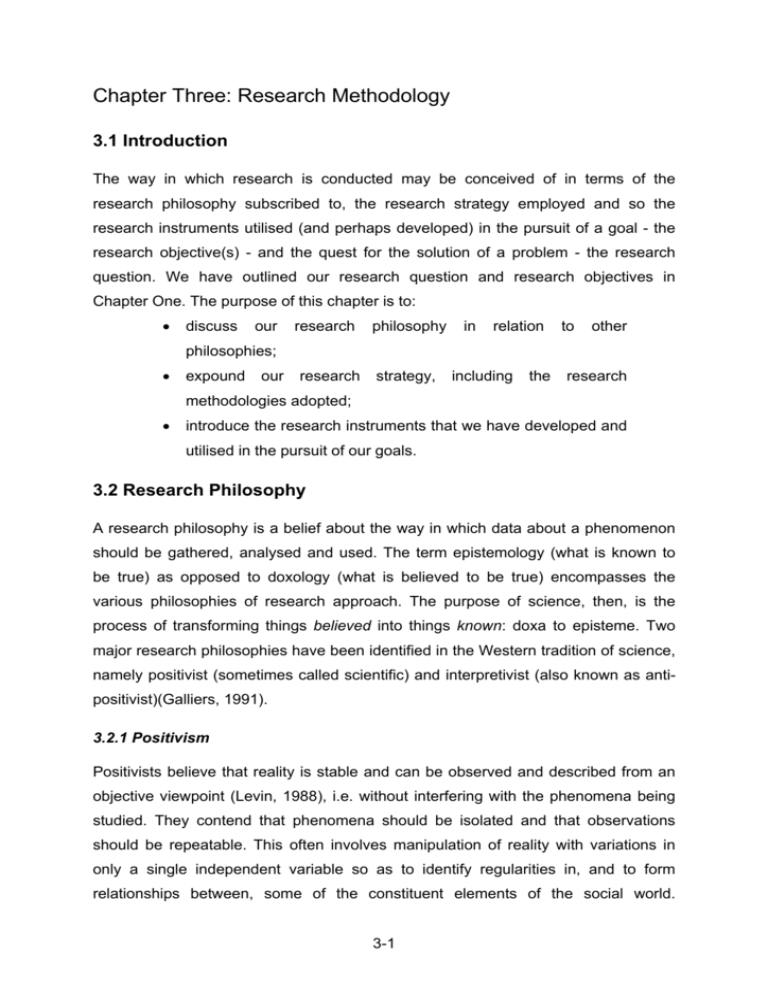
Chapter Three: Research Methodology 3.1 Introduction The way in which research is conducted may be conceived of in terms of the research philosophy subscribed to, the research strategy employed and so the research instruments utilised (and perhaps developed) in the pursuit of a goal - the research objective(s) - and the quest for the solution of a problem - the research question. We have outlined our research question and research objectives in Chapter One. The purpose of this chapter is to: • discuss our research philosophy in relation to other philosophies; • expound our research strategy, including the research methodologies adopted; • introduce the research instruments that we have developed and utilised in the pursuit of our goals. 3.2 Research Philosophy A research philosophy is a belief about the way in which data about a phenomenon should be gathered, analysed and used. The term epistemology (what is known to be true) as opposed to doxology (what is believed to be true) encompasses the various philosophies of research approach. The purpose of science, then, is the process of transforming things believed into things known: doxa to episteme. Two major research philosophies have been identified in the Western tradition of science, namely positivist (sometimes called scientific) and interpretivist (also known as antipositivist)(Galliers, 1991). 3.2.1 Positivism Positivists believe that reality is stable and can be observed and described from an objective viewpoint (Levin, 1988), i.e. without interfering with the phenomena being studied. They contend that phenomena should be isolated and that observations should be repeatable. This often involves manipulation of reality with variations in only a single independent variable so as to identify regularities in, and to form relationships between, some of the constituent elements of the social world. 3-1 Predictions can be made on the basis of the previously observed and explained realities and their inter-relationships. "Positivism has a long and rich historical tradition. It is so embedded in our society that knowledge claims not grounded in positivist thought are simply dismissed as ascientific and therefore invalid" (Hirschheim, 1985, p.33). This view is indirectly supported by Alavi and Carlson (1992) who, in a review of 902 IS research articles, found that all the empirical studies were positivist in approach. Positivism has also had a particularly successful association with the physical and natural sciences. There has, however, been much debate on the issue of whether or not this positivist paradigm is entirely suitable for the social sciences (Hirschheim, 1985), many authors calling for a more pluralistic attitude towards IS research methodologies (see e.g. Kuhn, 1970; Bjørn-Andersen, 1985; Remenyi and Williams, 1996). While we shall not elaborate on this debate further, it is germane to our study since it is also the case that Information Systems, dealing as it does with the interaction of people and technology, is considered to be of the social sciences rather than the physical sciences (Hirschheim, 1985). Indeed, some of the difficulties experienced in IS research, such as the apparent inconsistency of results, may be attributed to the inappropriateness of the positivist paradigm for the domain. Likewise, some variables or constituent parts of reality might have been previously thought unmeasurable under the positivist paradigm - and hence went unresearched (after Galliers, 1991). 3.2.2 Interpretivism Interpretivists contend that only through the subjective interpretation of and intervention in reality can that reality be fully understood. The study of phenomena in their natural environment is key to the interpretivist philosophy, together with the acknowledgement that scientists cannot avoid affecting those phenomena they study. They admit that there may be many interpretations of reality, but maintain that these interpretations are in themselves a part of the scientific knowledge they are pursuing. Interpretivism has a tradition that is no less glorious than that of positivism, nor is it shorter. 3-2 3.2.3 Discussion and Rationale for Choice of Approach Both research traditions start in Classical Greek times with Plato and Aristotle (positivists) on the one hand, and the Sophists (anti-positivists) on the other. After long, dark periods in European scientific thought, the renaissance of the discipline came in the sixteenth and seventeenth centuries. Since that time, well known positivists have included Bacon, Descartes, Mill, Durkheim, Russell and Popper. On the opposing side we have Kant, Hegel, Marx, Freud, Polanyi and Kuhn (Hirschheim, 1985). Vreede (1995) observes that in both Organisation Science and Information Systems research, interpretive research used to be the norm, at least until the late 1970s. Since that time, however, the positivist tradition has taken a firm hold (Dickson and DeSanctis, 1990), Orlikowski and Baroudi (1991) noting that 96.8% of research in the leading US IS journals conform to this paradigm. Pervan (1994b), in a review of 122 articles in the GSS literature, observes that only 4 (3.27%) could be described as interpretivist. It has often been observed (e.g. Benbasat et al., 1987) very accurately that no single research methodology is intrinsically better than any other methodology, many authors calling for a combination of research methods in order to improve the quality of research (e.g. Kaplan and Duchon, 1988). Equally, some institutions have tended to adopt a certain "house style" methodology (Galliers, 1991); this seems to be almost in defiance of the fact that, given the richness and complexity of the real world, a methodology best suited to the problem under consideration, as well as the objectives of the researcher, should be chosen (Benbasat, 1984; Pervan, 1994b). In this research, we have tried to avoid what may be characterised as methodological monism, i.e. the insistence on using a single research method. This is not due to an inability to decide between the various merits and demerits of the various alternatives. Instead, we believe that all methods are valuable if used appropriately, that research can include elements of both the positivist and interpretivist approaches, if managed carefully. Our over-riding concern is that the research we undertake should be both relevant to our research question, as set out in Chapter One, and rigorous in its operationalisation. Overall we believe that an interpretivist philosophy is required for this purpose, i.e. the understanding of how groups adopt and adapt to the use of 3-3 Information Systems, specifically Group Support Systems. This research involves an element of technology transfer, insofar as the technology was not previously installed in some of the organisations we study. This thus requires that we play a part in the implementation process. Furthermore, in order to measure how organisations can improve their meetings with the support of GSS, we make recommendations for use of the GSS after analysing existing meeting processes. To do all these things without being involved would be impossible. However, recognising the lack of objectivity sometimes associated with interpretivist research methods, we adopt a positivist, quantitative approach to the development of our key research instrument. These various elements of our research approach are further elaborated in the following sections: Research Strategy, Research Instruments, Facilitation Software and Research Operationalisation. 3.3 Research Strategy A large number of research methodologies have been identified, Galliers (1991) for example listing fourteen, while Alavi and Carlson (1992), reported in Pervan (1994b), use a hierarchical taxonomy with three levels and eighteen categories. In Table 3.1 below, we list the methodologies identified by Galliers (1991, p.149), indicating whether they typically conform to the positivist or interpretivist paradigms. Before introducing the methodologies we use in this research, we summarise the key features of the key methodologies in the table, identifying their respective strengths and weaknesses. In the following sections, we justify our choice of methodologies and explain how they both operate and interoperate in our research. Table 3.1 A Taxonomy of Research Methodologies Scientific/Positivist Interpretivist/Anti-positivist Laboratory Experiments Subjective/Argumentative Field Experiments Reviews Action Research ü Case Studies Case Studies ü Theorem Proof Descriptive/Interpretive Forecasting Futures Research Simulation Role/Game Playing Surveys ü 3-4 Laboratory experiments permit the researcher to identify precise relationships between a small number of variables that are studied intensively via a designed laboratory situation using quantitative analytical techniques with a view to making generalisable statements applicable to real-life situations. The key weakness of laboratory experiments is the "limited extent to which identified relationships exist in the real world due to oversimplification of the experimental situation and the isolation of such situations from most of the variables that are found in the real world" (Galliers, 1991, p.150). Field experiments extend laboratory experiments into real organisations and their real life situations, thereby achieving greater realism and diminishing the extent to which situations can be criticised as contrived. In practice it is difficult to identify organisations that are prepared to be experimented on and still more difficult to achieve sufficient control to make replication viable. Surveys enable the researcher to obtain data about practices, situations or views at one point in time through questionnaires or interviews. Quantitative analytical techniques are then used to draw inferences from this data regarding existing relationships. The use of surveys permit a researcher to study more variables at one time than is typically possible in laboratory or field experiments, whilst data can be collected about real world environments. A key weakness is that it is very difficult to realise insights relating to the causes of or processes involved in the phenomena measured. There are, in addition, several sources of bias such as the possibly self-selecting nature of respondents, the point in time when the survey is conducted and in the researcher him/herself through the design of the survey itself. Case studies involve an attempt to describe relationships that exist in reality, very often in a single organisation. Case studies may be positivist or interpretivist in nature, depending on the approach of the researcher, the data collected and the analytical techniques employed. Reality can be captured in greater detail by an observer-researcher, with the analysis of more variables than is typically possible in experimental and survey research. Case studies can be considered weak as they are typically restricted to a single organisation and it is difficult to generalise findings since it is hard to find similar cases with similar data that can be analysed in a statistically meaningful way. Furthermore, different researchers may have different interpretations of the same data, thus adding research bias into the equation. 3-5 Simulation involves copying the behaviour of a system. Simulation is used in situations where it would be difficult normally to solve problems analytically and typically involves the introduction of random variables. As with experimental forms of research, it is difficult to make a simulation sufficiently realistic so that it resembles real world events. Forecasting/futures research involves the use of techniques such as regression analysis and time series analysis to make predictions about likely future events. It is a useful form of research in that it attempts to cope with the rapid changes that are taking place in IT and predict the impacts of these changes on individuals, organisations or society. However, it is a method that is fraught with difficulties relating to the complexity of real world events, the arbitrary nature of future changes and the lack of knowledge about the future. Researchers cannot build true visions of the future, but only scenarios of possible futures and so impacts under these possible conditions. Subjective/argumentative research, for example hermeneutics and phenomenology) requires the researcher to adopt a creative or speculative stance rather than act as an observer. It is a useful technique since new theories can be built, new ideas generated and subsequently tested. However, as an unstructured and subjective form of research, there is a strong chance of researcher bias. Action research is a form of applied research where the researcher attempts to develop results or a solution that is of practical value to the people with whom the research is working, and at the same time developing theoretical knowledge. Through direct intervention in problems, the researcher aims to create practical, often emancipatory, outcomes while also aiming to reinform existing theory in the domain studied. As with case studies, action research is usually restricted to a single organisation making it difficult to generalise findings, while different researchers may interpret events differently. The personal ethics of the researcher are critical, since the opportunity for direct researcher intervention is always present. 3.3.1 Survey Research According to our research objectives, we intend to investigate existing meetings thought to be potentially suitable for GSS support. In order to determine both how we can most effectively use GSS in that support role, and, later on, how well we have achieved our goals, we have developed an instrument to measure meeting 3-6 processes. This instrument is administered to meeting participants before the GSS is implemented and regularly throughout the duration of a case study. It is a key data collection device. This instrument has been validated through statistical means with large data samples. We describe the exact development and validation processes of the instrument in Chapter Four. 3.3.2 Case Study Research There are a number of important articles describing the case study approach to research that we refer to. Key among these is Benbasat et al.'s (1987) paper with its comprehensive definitions and suggestions for the conduct of case research. A second paper, and one that is closer to the GSS domain, is Pervan (1994b). The case study is considered by Benbasat et al. (1987, p.370) to be viable for three reasons: • It is necessary to study the phenomenon in its natural setting; • The researcher can ask "how" and "why" questions, so as to understand the nature and complexity of the processes taking place; • Research is being conducted in an area where few, if any, previous studies have been undertaken. Case studies are defined in various ways and a standard does not exist. However, a definition compiled from a number of sources (Stone, 1978; Benbasat, 1984; Yin, 1984; Bonoma, 1985 and Kaplan, 1985) in Benbasat et al. (1987, p.370), runs as follows: A case study examines a phenomenon in its natural setting, employing multiple methods of data collection to gather information from one or a few entities (people, groups or organizations). The boundaries of the phenomenon are not clearly evident at the outset of the research and no experimental control or manipulation is used. When deciding whether to use the case study approach or not, there are a number of factors to consider. If there is a need to focus on contemporary events or phenomena in a natural setting, clearly the case study is advantageous. The same is 3-7 also true if there is no strong theoretical base for the research, i.e. if it is a theory building research project. "A rich and natural setting can be fertile ground for generating theories" (Benbasat et al., 1987). However, if there is a need for control or manipulation of variables, then the case study would not be appropriate. It is important to clarify that need should relate to the nature of the problem rather than the (in)ability of the researcher(s) to undertake research with a particular methodology. Within the case study approach there are a number of variations. A key feature of the design of case study research is the number of cases included in a project. Generally speaking it is better, i.e. more valid and generalisable, to include multiple cases, though there are instances where a single case is instructive (see e.g. Lee, 1989). Exploratory studies are generally better served by single cases, i.e. where there is no previous theory. A single case can also be used to test an existing, well-formed theory. Multiple cases are preferable when the purpose of the research is to describe phenomena, develop and test theories. Multiple cases also permit cross-case analysis, a necessary feature for widespread generalisation of theories. The sites or locations where cases are to be conducted should be chosen with great care. It is not appropriate to use an opportunistic approach, using whichever site is available purely on the grounds that it is available. In this study, we have reviewed a substantial number of sites and found that most are unsuitable for the introduction of GSS. This is explained further in 3.6 below. As has already been indicated, case studies require multiple data collection methods, whose results hopefully converge, in order to establish construct validity. Yin (1984, p.78) identifies these methods as including: • direct observation of activities and phenomena and their environment; • indirect observation or measurement of process related phenomena; • interviews - structured or unstructured; • documentation, such as written, printed or electronic information about the company and its operations; also newspaper cuttings; • records and charts about previous use of technology relevant to the case. Of these, the second, i.e. survey of participant attitudes through a questionnaire, is the method that has required most developmental effort and is explained separately in Chapter Four. 3-8 3.3.3 Action Research The origins of action research, and the ways in which action research is both perceived and conducted today, are open to dispute, yet it "has been a distinctive form of inquiry since the 1940s" (Elden and Chisholm, 1993). The term 'action research' is popularly attributed to Kurt Lewin (1946), though other authors at the same time were calling for similar action oriented approaches to research (e.g. Collier (1945) and Corey (1953)). Elden and Chisholm (1993) go on to note that action research is change oriented, seeking to introduce changes with positive social values, the key focus of the practice being on a problem and its solution. Thus, Sanford (1970) views action research as a form of problem-centred research that bridges the divide between theory and practice, enabling the researcher to develop applicable knowledge in the problem domain (Peters and Robinson, 1984). Palmer and Jacobson (1971) see action research as a means of using research to promote social action. Further to these descriptions, Rapoport (1970) identifies action research as a form of inquiry that seeks to address both the practical problems of people and the goals of social science within a "mutually acceptable ethical framework" (Susman, 1985). Among contemporary action researchers, Argyris et al.'s (1985, p.4) description is most informative, viz.: "Action science is an inquiry into how human beings design and implement action in relation to one another. Hence it is a science of practice …". Action research may thus be said to occur when scientists "engage with participants in a collaborative process of critical inquiry into problems of social practice in a learning context" (op. cit. p.237). Heller (1993, p.1239) also observes that "the AR approach … is particularly appropriate for solving problems for which past research has provided, at least a starting point and for the time being, a reasonably accepted scientific model supported by evidence. AR can then test the evidence against the model, refine it, or improve on it". Where action research in practice is concerned, it would appear that it has traditionally taken place in domains such as social action, education, business and criminology, but to a considerably lesser extent in mainstream psychology (Sanford, 1970). Considering how action research should be undertaken, Kemmis (1980) notes that it involves the application of tools and methods from the social and behavioural 3-9 sciences to practical problems with the dual intentions of both improving the practice and contributing to theory and knowledge in the area being studied. Action researchers either participate directly in or intervene in a situation or phenomenon in order to apply a theory and evaluate the value and usefulness of that theory (Checkland, 1981, 1991; Argyris and Schön, 1989; Dick, 1993; Vreede, 1995). Thus action research can be used not only for theory testing, but also theory building and/or expanding (Galliers, 1991). Eden and Huxham (1996) observe that the intervention of the researcher will often result in changes within the organisation studied and will therefore challenge the status quo. They also emphasise (op. cit. p.84) that action research must have implications "beyond those required for action … in the domain of the project. It must be possible to envisage talking about the theories developed in relation to other situations. Thus it must be clear that the results could inform other contexts …". When undertaking action research, the researcher starts with planning, continues to execution (intervention), observation and reflection, before returning to planning and a new cycle (Checkland, 1991; Zuber-Skerrit, 1991; Dick, 1993). The planning itself typically relates to a social or practical problem rather than a theoretical question (Kemmis, 1981). Furthermore, the researcher should attach importance to the values, beliefs and intentions of the participants in the study as s/he attempts to change social reality for the better in an emancipatory frame of reference (Peters and Robinson, 1984). Ledford and Mohrman (1993) and Elden and Chisholm (1993) emphasise that participants themselves need to be actively involved in the research process, sometimes to the extent that they become coresearchers. Some researchers position action research as a subset of case study research (Benbasat et al., 1987; Galliers, 1991), but others (e.g. Vreede, 1995) observe the differences between the two approaches and thus appear to suggest that they should be treated as separate methods. We contend, however, that the three reasons that Benbasat et al. (1987) believe make case study research viable are equally true for action research (see 3.3.2 above). We highlight the differences between action research and case studies in Table 3.2 below. 3-10 Table 3.2 Case Studies and Action Research (adapted from Vreede, 1995) Case Study Action Research Researcher is observer Researcher is active participant Exploratory, explanatory or descriptive Prescriptive, intervening Focus on "How?" and "Why?" Additional focus on "How to?" May be positivist or interpretivist Usually interpretivist Action research articles are written by those who had the original intention of effecting change whilst pursuing their research (Susman and Evered, 1978), with the action researcher therefore becoming either a participant or a consultant, though the extent to which s/he is involved varies from case to case. Indeed, there is a continuum between the "describer" of case studies and the "implementer" of action research. In the middle is an "observer" who has social interaction with participants, yet is not a participant in the meeting content (Waddington, 1994). Such a research methodology is strong in the sense that it provides the researcher with an inside and working view of a case, but weak as it may not be as objective as other methodologies. The involvement of the participants in the case also varies from those who get involved with the analysis and reflective learning, to those who prefer only to act. Our identification with action research is as follows: we are interested in exploring a hitherto unexplored situation - the use of GSS in business and professional environments in Hong Kong, thereby allowing us to develop theories that are appropriate to the use of GSS in Hong Kong. We believe that any theory we can develop, or refine, as a result of our attempt to understand these concrete environments is more likely to remain applicable to other concrete environments (cf. Susman, 1985). We are also interested in obtaining feedback from the situation we are investigating, analysing this feedback and using it to change the existing conditions, and hopefully improve them. Whilst we can obtain information through a survey, as well as through other sources, we cannot use this information directly in the case without intervening in the phenomena we are studying - the meeting groups and their electronic support. The action element is also present in the fact that we are introducing the technology to the groups: it is not extant. 3-11 3.3.4 The Action Research - Case Study: A Combined Approach While Benbasat et al. (1987) indicate that action research belongs to the case study family of methodologies, we intentionally treat them as separate forms. We note that an action research study is likely to include cases, but a case study can certainly avoid using action research. In this research, we choose to use both methodologies for various reasons which relate back to the reasons we gave why each methodology should be used. The phenomenon we are measuring (group meetings that involve business and professional people in discussion-based tasks in which they have a vested interest) is too complex, we believe, to be constructed and measured experimentally, particularly as we should pay attention to the organisational (and local) idiosyncrasies that permeate all true natural settings. Asking "how" and "why" questions will help us to understand the nature of the processes, while asking "how to" questions will assist us to interpret the data we collect and so to improve our support of the groups whose meetings we are facilitating. We are not aware of previous research in this area, which means that we are involved in theory building an area where case studies are acknowledged as providing a suitable climate for data collection and theory construction. We believe that in this bi-methodological combination, the researcher should take on the role of a consultant and observer but avoid becoming a participant as far as is possible, restricting himself to meeting process dynamics. To clarify further, the researcher is the driver of the technology, but is not the manager or owner of the meeting. He adjusts the use and application of the technology so as to meet the needs of the group, but does not concern himself with actual content, which is the domain of the meeting owner or manager. This approach offers the IS discipline the opportunity to identify rich and varied, yet also relevant, research possibilities. In order to ensure construct validity, we have already observed the requirement for multiple data collection methods. The use of an empirically validated instrument which we have designed adds immeasurably to the rigour of the research. It is instructive to note some of the methodological strengths and weaknesses that Benbasat et al. (1987) identified in their review of case study articles and explain how we propose to achieve and avoid, respectively, those same strengths and weaknesses. These are presented in Table 3.3 below. 3-12 Table 3.3 Strengths and Weaknesses of Published Case Study Articles STRENGTHS W EAKNESSES Excellent detail on implementation process. Lack of detail about data collection methodology, e.g. interview questions were not listed out. Poor explanation of site selected for research. Inadequate explanation of where research lies in the knowledge building process, and therefore inadequate explanation of research purpose. The use of triangulation to increase reliability of results was seldom encountered. Longitudinal methodologies seldom used. Research objectives seldom and poorly stated. Lack of detail about data sources used. Clear research objectives stated. Possible explanations were provided for the outcomes measured. Causal links between outcomes were suggested. It is apparent that some of these strengths and weaknesses directly oppose one another, e.g. well and poorly defined research objectives. Some of these issues have already been covered in Chapter One - research rationale, research objectives and research questions. Others have been covered earlier in the current chapter, i.e. where the research lies in an overall framework of knowledge building. Still others are inappropriate for discussion at this juncture, but are addressed in a later section of this chapter - research operationalisation where we discuss data collection, site location and longitudinal measurement. 3.4 Research Model and Instrument We have identified three key areas of literature that are relevant to this research Group Support Systems (and its associated technology); the socio-psychological aspects of group processes; and the nature of relationships between national culture, organisations and Group Support Systems. Following a comprehensive review of this literature (in Chapter Two), we develop a research framework. The research framework is fully explained in Chapter Four. Such frameworks are by no means new, many having been presented by earlier researchers. The most well known and frequently cited of these is the Dennis et al. (1988) model. Our own framework represents an expansion of this model, necessitated by the inclusion of culture and other factors we believe to be important. The framework itself is too 3-13 large to be researched in a single project and therefore we concentrate on particular items within it. These are highlighted so as to indicate more precisely our own areas of focus. The research framework is also invaluable in that it guides us in our development of an instrument to measure participants' perceptions of processes in meetings. Due to the nature of our research problem, we decided that it would be essential to measure existing meeting processes, i.e. in non-GSS supported situations. A critical weakness of much previous research in the GSS domain, we believe, has been the inadequate attention paid to the justification to use GSS in the first place. This is akin to Benbasat et al.'s (1987) criticism of the inadequacy of statement of research purposes and research objectives in their review of case study research. We believe that it is of fundamental importance firstly to identify which organisations are suitable for GSS support, then (if they are suitable) to analyse their unsupported meetings and elicit process related problems that the GSS may be able to help improve, then to intervene with the software (this is the action research element) and so attempt to ameliorate the situation. We discuss the process of identifying organisations in 3.6.3. In order to analyse those meetings, however, it is essential to have a validated and reliable instrument in order to collect information both prior to GSS implementation and post-implementation, i.e. to measure how successful the implementation has been. The process of developing and validating this instrument (Davison, 1997), and indeed the reasons why we felt it necessary to develop a new instrument rather than use an existing one, are fully explained in Chapter Four. 3.5 Research Facilitation Software In this research, we employ the GSS software - GroupSystems v.1.11. GroupSystems was developed at the University of Arizona and is currently marketed by Ventana Corporation. Our choice of software has been affected by a number of considerations. GroupSystems is, arguably, the most widely used GSS product in the commercial marketplace. It has a long developmental history (see Dennis et al., 1988; Davison, 1995b) and runs on the Windows platform that is standard to the operating environment with which we are familiar. Furthermore, the researcher has 1 Different versions were used. In cases 1 and 2, 1.1b; in cases 3 and 4, 1.1c, 1.1d and 1.1dSP2. 3-14 both visited GSS facilities and been involved with some of the GroupSystems developers at the University of Arizona during the course of this PhD on joint projects (e.g. Davison and Briggs, 1997). This has permitted a much closer and more detailed examination of the way in which the software has been developed and is maintained. Whilst we recognise the existence of other products in the marketplace (see Davison (1995a) for a review) we are generally satisfied with the capability of GS and the technical support we receive from Ventana. This is a critical element of our choice, since technical responsiveness and communication via email, when there is no local distributor in Hong Kong (for any GSS product), is vital. As part of the joint research project, Ventana has made available lists of its commercial customers for us to approach in Hong Kong, i.e. Hong Kong branches of overseas organisations which use GS in their overseas branches. This has been most useful in terms of identifying potential sites and is explained in greater detail below. GroupSystems incorporates a number of tools, of which we utilise primarily the Categoriser, Group Outliner, Vote and Survey (see 2.2.5). Other than Survey, which is designed as an electronic questionnaire, all three tools permit comments to be attached to ideas, outlines and ballot items thus facilitating the group in its meeting process. GroupSystems is designed to be a facilitator-led software, with the facilitator or meeting manager exerting control over the amount of freedom or power participants have to become involved in the organisation of the meeting. At the low end, participants are entirely subject to the authority of the manager and may be permitted only to create or evaluate ideas and add comments to those ideas. At the high end, they can modify or delete existing ideas, add new categories (in the Categoriser), view each other's login profiles, move ideas around the different categories, even delete the categories themselves. The high degree of flexibility given to the manager is useful, since different groups with different levels of software experience require different forms of facilitation in order to achieve meeting success. The extent of GSS facilitation provided is indicated in the case studies. Clearly a basic requirement for a group is that it have access to a network of PCs (preferably one PC per participant) on which to run the GSS software, though meeting members can be in either face-to-face or distributed environments. 3-15 3.6 Research Operationalisation 3.6.1 Introduction It has been commented that "...the use of GDSS technology should be fine-tuned to the task and setting for which it will be used" Gallupe and McKeen (1990, p.11). Cass et al. (1992, p.181) take this notion of fine-tuning a step further, observing: "...we must better understand how to design the technology, how to train people to use it, and how to better support different types of groups with it. Practitioners must carefully identify which groups will benefit from groupware, which functions of groupware are useful to a particular team, and whether a dispersed team can meet effectively". In the pursuit of our research objectives, we do not believe that it is acceptable to conduct experimental research with students who in no way resemble the businessmen and professionals they would unwittingly substitute. Furthermore, it is equally unacceptable to use GSS software for any and every situation without understanding how or why it might be useful in that situation. This is akin to the prescription of a wonder drug to a patient in the expectation that it will have a good effect, without understanding anything about the patient's condition, symptoms, allergies or other underlying problems. 3.6.2 An Analogy It is informative and valuable to present a short, fictitious case which not only extends the medical analogy, but provides a example of how we envisage that our research will proceed: A patient is admitted to hospital with an as yet unspecified disease or condition. Working with the patient, a diagnosis needs to be made on the basis of visible or measurable symptoms in order to understand the situation and, therefore, to prescribe treatment in consultation with the patient. Post-diagnosis, treatment is suggested to the patient who may revise, modify or decline the suggestion and the patient is monitored for 3-16 signs of improvement or deterioration. Re-evaluation or represcription may be necessary. Of course, not all diseases can be diagnosed, nor is there always suitable treatment available or known. Furthermore, experience plays a major role in the diagnostic process. As an action researcher, we observe the symptoms, reflect on them with the subjects, suggest a plan for a course of treatment and participate in its execution. This cyclic process continues in the same manner, with subsequent "plans" being modified according to the reactions of the "patient". In our research, we intend, where possible, to examine and measure existing meeting processes, reflect upon them, plan a course of action and execute it. During and after each meeting, further measurements are made and so the process cycles forward. An end comes when the purpose of the group is completed or when a predetermined time allocation expires. 3.6.3 Operational Details For each potential "patient" organisation or group, we first present a manager or equivalent with a description of the purpose and operational nature of the software, explaining how GSS have helped other organisations, as well as giving details of possible scenarios where GSS promote gains in meeting productiveness, efficiency and so forth. Two basic criteria for eligible meetings are that they: a) occur at regular and reasonably frequent intervals (this aids the meeting participants to learn and remain familiar with the technology); and b) involve primarily discursive rather than disseminative topics. If the organisation's representative believes that GSS could indeed be introduced to the organisation so as to improve meeting processes, the researcher attends a sample meeting so as to gauge the general meeting atmosphere, and 3-17 observe meeting processes and interpersonal interactions first-hand. Key questions that the researcher attempts to answer at this stage are: • Is the meeting membership hierarchically structured and what impact does this have on meeting processes? • Do all meeting members appear to participate freely and at will? • Do some meeting members appear to influence or intimidate others (whether intentionally or not)? • Do meeting members appear to have a lot to say but have to wait for the chance to do so? • Does the group make a lot of reference to materials that may have been discussed in previous meetings? Through understanding meeting processes and interactions, it is usually possible to 'interpret' how appropriate a GSS is likely to be for a given meeting. If judged appropriate by the researcher and organisation, the instrument (described above) may also be used to collect data about the meeting processes. The instrument permits us to identify process related problems in the meeting, and then prescribe a solution for resolution of those problems. We expect that the accuracy of the prescriptions will become more accurate with time, i.e. with increasing experience. In this way we can overcome the weakness we perceive in much previous GSS research, i.e. the failure to identify why a particular GSS operationalisation was used, even why GSS was used at all. We do not make the assumption that GSS will always have a positive effect, though we do believe that having undertaken a careful selection procedure to locate appropriate groups, we increase the chance of the GSS use being successful. As well as attempting to use the GSS to support identified meeting process weaknesses or problems, we also attempt to enable those positive features that we identify. The precise nature of the prescription depends on the individual cases, and hence is flexible. We explore the prescriptions in detail in Chapters Five to Eight. Following the first, and each subsequent, GSS supported meeting, the questionnaire should be completed by all meeting participants. The post-session questionnaires are administered through the electronic survey tool, mentioned in 3.5 above. This permits us to obtain more accurate feedback from participants who are not, for example, able to give the conflicting answers (multiple ticks, answers, etc.) 3-18 sometimes found on pen-filled questionnaires. Since the participants use the GSS software for their meetings, it seems reasonable to require them to use a GSS tool for process-related data collection as well. The data collected is analysed with a view to extracting meeting process characteristics that give cause for concern. If, for example, we observe that a majority of participants feel intimidated by the behaviour of some other members, we might attempt to reduce this through anonymous communications, thereby enabling ideas to be separated from their authors and so removing status cues. Equally if the result orientation of the meeting seems weak, additional focus provided by the facilitator may be required. This data is supplemented by observations made by the researcher during the meeting - who is talking, who they talk to, what they talk about, what they prefer to talk rather than type, and so on. It should also be supplemented with information derived from interviews conducted with meeting members separate from the meeting. By taking a longitudinal approach, we are able to measure how the problems we originally identified are improved, worsened or otherwise changed through the use of the technology. This is thus an indication of the accuracy of our prescription. Needless to say, we maintain that the technology is not the panacea for all problems (cf. Ellul, 1964; Grudin, 1994), and therefore the technology must not be allowed to drive the solution. The researcher involved in this action research plays the role of the meeting facilitator, but not the process owner, adjusting use of the technology so as to fit the process needs of the group most effectively. The role of the meeting manager or owner is also critical in that s/he must direct the facilitator or otherwise involve the facilitator in the meeting process. At times this may require the facilitator to play a slightly more active role, giving advice on tool suitability or the sequence of activities. However, generally speaking it is the processes underlying the meeting, as perceived by the participants, that we are interested in, not the content. 3.7 Summary In this chapter we have presented a detailed account of the research philosophy, strategy and methodology according to which we shall conduct this research. We place our research in both the positivist and the interpretivist camps, utilising a 3-19 mixture of survey, case study and action research approaches. Previous literature describing case studies is valuable in identifying the salient points of the case study methodology, as well as illustrating the weaknesses associated with earlier research. While fewer materials concerning action research are readily available, we explain how we propose to interoperate the two interpretivist methods so as to achieve our research objectives. This includes a substantial literature review, the enhancement of earlier research models and the development of an instrument. These are explained in much greater detail elsewhere in the thesis and in other published papers. Finally we detail the operationalisation of the practical side of the thesis - the cases - recounting how we have identified suitable organisational groups for study and detailing our broad procedures for data analysis and software intervention. In Chapter Nine, we will revisit the action research methodology, analysing it in the context of the cases we will have by then undertaken, and discussing its appropriateness for this type of research. 3-20

